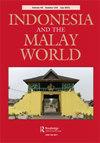The Kubrawī and early Javanese Islam
IF 0.9
3区 社会学
0 ASIAN STUDIES
引用次数: 1
Abstract
ABSTRACT Beyond somewhat vague allusions to Sufi influence, a qualitative sense of early Javanese Islamic praxis remains sadly lacking among scholars. This article attempts to rectify that deficiency by re-assessing the importance of a Kubrawī silsila (spiritual genealogy) found within the 17th- to early 18th-century Javanese chronicle, Sejarah Banten Ranté-Ranté. First identified by Martin van Bruinessen in 1994, this silsila preserves detailed information about two separate Sunni-orientated Kubrawī lineages attributable to the latter’s Central Asian sub-branch, the Hamadānī. Set within the context of other early Javanese Muslim texts containing previously overlooked evidence of Kubrawī praxis, in addition to hagiographical traditions identifying one Jumadil Kubra (a probable cypher for Kubrawī founder, Najm al-Dīn al-Kubrā) as the island’s earliest Muslim practitioner and a resident of Gresik, we argue that this silsila indicates considerable Kubrawī influence over Java’s initial Islamisation. Further consideration of the silsila’s specific Hamadānī characteristics set against wider 13th- to 15th-century Islamic history suggests either a north Indian or, more probably, Sino-Muslim origin for that influence. We therefore conclude by interpreting the Sejarah Banten silsila as a possible window onto the substantive nature of Sino-Muslim involvement in early Javanese Islam, adding further nuance to our understanding of that island’s Islamisation.摘要除了对苏菲影响的模糊暗示外,令人遗憾的是,学者们仍然缺乏对早期爪哇伊斯兰实践的定性认识。本文试图通过重新评估在17世纪至18世纪初的爪哇编年史Sejarah Banten Ranté-Ranté中发现的Kubrawīsilsila(精神谱系学)的重要性来纠正这一缺陷。1994年,Martin van Bruinessen首次发现了这一silsila,它保存了两个独立的逊尼派Kubrawī谱系的详细信息,这两个谱系可归因于后者的中亚分支Hamadānī。在其他早期爪哇穆斯林文本的背景下,这些文本包含了以前被忽视的Kubrawīpraxis的证据,除了将一位Jumadil Kubra(可能是Kubrawā创始人Najm al-Dīn al-Kubrā的密码)认定为该岛最早的穆斯林修行者和Gresik居民之外,我们认为,这种silsila表明Kubrawī对爪哇最初的伊斯兰化有相当大的影响。在更广泛的13至15世纪伊斯兰历史背景下,进一步考虑silsila的特定Hamadānī特征,表明这种影响要么来自北印度,要么更可能来自中国穆斯林。因此,我们最后将Sejarah Banten silsila解释为了解中国穆斯林参与早期爪哇伊斯兰的实质性的可能窗口,为我们对该岛伊斯兰化的理解增添了更多的细微差别。
本文章由计算机程序翻译,如有差异,请以英文原文为准。
求助全文
约1分钟内获得全文
求助全文
来源期刊

Indonesia and the Malay World
ASIAN STUDIES-
CiteScore
2.00
自引率
0.00%
发文量
17
期刊介绍:
Indonesia and the Malay World is a peer-reviewed journal that is committed to the publication of scholarship in the arts and humanities on maritime Southeast Asia. It particularly focuses on the study of the languages, literatures, art, archaeology, history, religion, anthropology, performing arts, cinema and tourism of the region. In addition to welcoming individual articles, it also publishes special issues focusing on a particular theme or region. The journal is published three times a year, in March, July, and November.
 求助内容:
求助内容: 应助结果提醒方式:
应助结果提醒方式:


